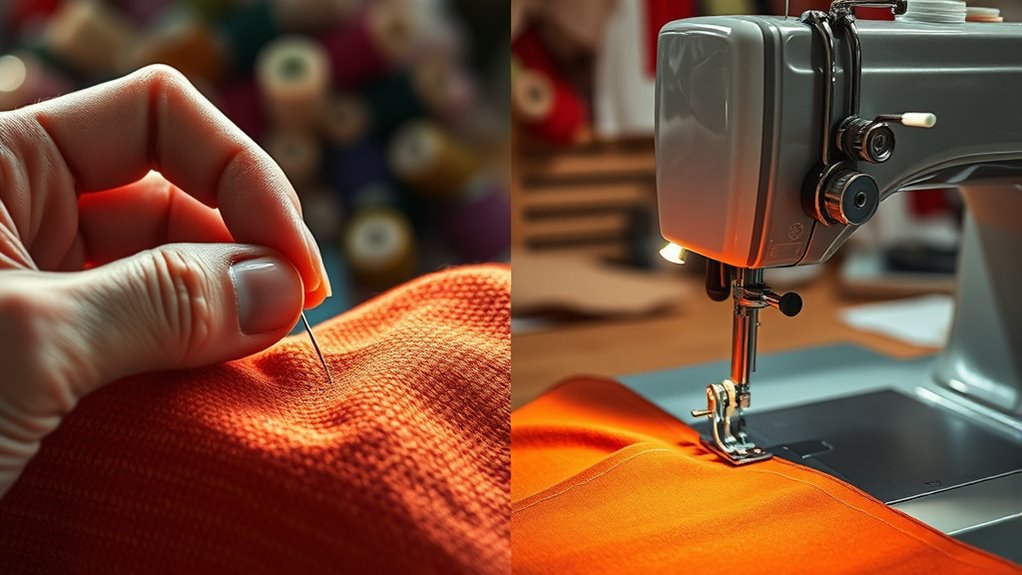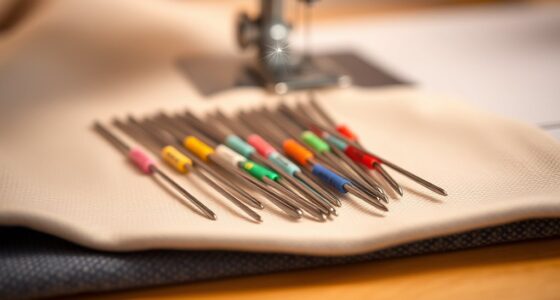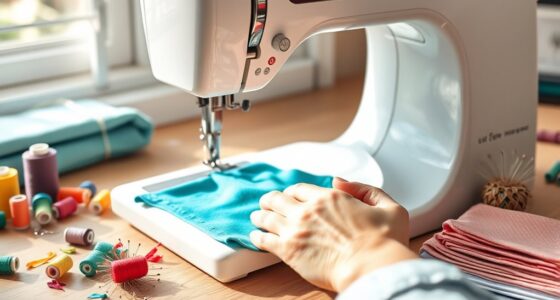When deciding between hand sewing and machine sewing, consider your fabric type, project size, and desired detail. Use hand sewing for delicate fabrics, intricate embroidery, or small repairs, where control is key. Opt for machine sewing on sturdier fabrics or larger projects to save time and achieve strong stitches. Each method has its place—if you want to master when and how to choose, keep exploring for more tips.
Key Takeaways
- Use hand sewing for delicate fabrics, detailed embroidery, and small repairs requiring precision.
- Opt for machine sewing for sturdy fabrics, large projects, and when speed and efficiency are priorities.
- Hand sewing offers greater control on fragile materials, preventing puckering or damage.
- Machine sewing accelerates production on bulk items like garments or quilting projects.
- Choose hand sewing for intricate, decorative work; select machine sewing for functional, large-scale stitching.

Have you ever wondered whether sewing by hand or with a machine is better? The answer depends on what you’re trying to accomplish. Both methods have their strengths, especially when it comes to fabric types and sewing speed. When you’re working with delicate fabrics like silk or chiffon, hand sewing often gives you more control and precision. These fabrics can be easily damaged by the tension or rough handling of a machine. Hand sewing allows you to carefully manipulate the fabric, avoiding puckering or stretching, and ensures neat, invisible stitches. Conversely, for sturdier fabrics like denim or canvas, a machine can handle the thicker material more efficiently, producing consistent stitches quickly and evenly. Additionally, many Ulta Beauty Store Hours locations offer sewing classes or supplies, which can help improve your skills.
Hand sewing offers precision with delicate fabrics, while machines excel with sturdier textiles for efficiency.
Sewing speed is a major factor when choosing between hand and machine sewing. If you need to complete a project quickly, a sewing machine is usually the way to go. Machines can stitch at a much faster pace than you could ever manage by hand, especially when working on larger pieces or multiple garments. This efficiency saves you time and energy while still delivering professional-looking results. However, speed isn’t everything. For intricate or detailed work, like embroidery or hand-stitched embellishments, taking your time with hand sewing provides the precision needed to achieve high-quality results.
Another consideration is the type of project you’re working on. For small repairs or quick fixes, hand sewing might be more practical. It’s portable, requires minimal setup, and allows you to sew anywhere—whether it’s on a train, in a park, or at your kitchen table. Plus, hand sewing can be more forgiving for beginners, helping you develop your skills slowly and carefully. On the other hand, for large projects like quilting or making multiple garments, a sewing machine dramatically speeds up the process and offers features like zigzag stitches, buttonholes, and decorative stitches that are difficult or impossible to do by hand.
Ultimately, the decision comes down to the fabric type, the project scope, and your desired sewing speed. Hand sewing excels with delicate fabrics and detailed work, providing control and finesse. Meanwhile, machine sewing is unbeatable for bulkier fabrics and larger projects where speed and efficiency matter most. Knowing when to use each method allows you to optimize your sewing experience, ensuring your projects look professional and are completed in a timely manner. Whether you prefer the quiet patience of hand sewing or the rapid results of machine sewing, understanding these factors helps you choose the best approach for every task.
Frequently Asked Questions
Can Hand Sewing Be Faster Than Machine Sewing?
Hand sewing can sometimes be faster than machine sewing, especially for small, simple tasks like quick repairs or delicate work. The speed comparison depends on your skill level and the project’s complexity. While machine sewing offers greater efficiency for larger or repetitive tasks, hand sewing provides precision, control, and better handling of intricate details. Choose hand sewing when you need meticulous accuracy, but for speed, machines often win out.
Is Hand Sewing Suitable for Heavy-Duty Fabrics?
Hand sewing isn’t ideal for heavy fabrics because it often lacks the stitch strength needed for durability. Heavy fabrics require stronger, more consistent stitches that a sewing machine can provide efficiently. If you’re working with thick or dense materials, using a machine ensures your seams hold up over time. Hand sewing can be suitable for delicate details or small repairs, but for heavy-duty projects, a machine is the better choice for strength and speed.
How Durable Are Hand-Sewn Stitches Compared to Machine Stitches?
Imagine threads like tiny warriors, fighting wear and tear over time. Hand-sewn stitches, with carefully chosen thread strength, can be surprisingly durable, especially for delicate or artistic projects. However, machine stitches usually offer longer stitch longevity and consistent strength, making them ideal for heavy-duty fabrics or items needing extra resilience. Your choice depends on the task—trust your stitches to hold through daily wear and tear.
Can Hand Sewing Be Used for Professional Garment Construction?
Yes, you can use hand sewing for professional garment construction, especially for intricate embellishment techniques and heirloom stitching. Hand sewing allows you to add detailed, delicate touches that machines can’t replicate, giving garments a unique, artisanal quality. While it’s more time-consuming, skilled hand sewing elevates high-end pieces and custom designs, showcasing craftsmanship. Use it for finishing touches, embroidery, or delicate seams where precision and elegance are essential.
What Tools Are Essential for Beginner Hand Sewing Projects?
For beginner hand sewing projects, you need essential tools like a variety of sewing needles and different thread types. Choose needles suitable for your fabric, such as sharps or embroidery needles, and select thread types like cotton, polyester, or silk based on your project. Keep a thimble handy to protect your finger, and use scissors to trim excess thread. These basics will help you sew accurately and confidently from the start.
Conclusion
Whether you choose hand sewing or machine sewing, think of each as a brushstroke in your creative masterpiece. Hand sewing offers the gentle touch of a whisper, perfect for delicate details, while the machine roars like a confident artist, ideal for swift, sturdy stitches. Knowing when to wield each tool transforms your sewing projects from simple fabric to a work of art. Embrace both, and watch your sewing skills blossom like a vibrant garden in full bloom.









